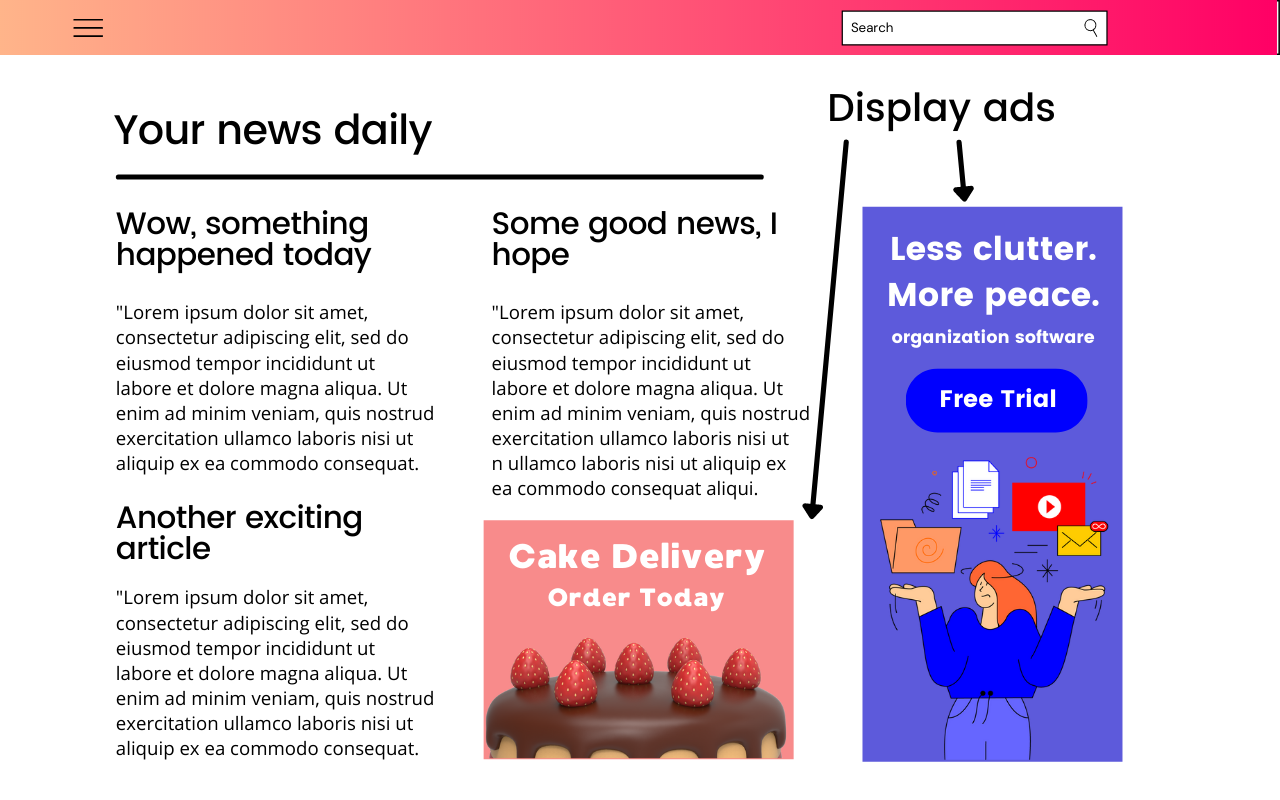How to Promote Your Squarespace Website Using Google Ads
If you have a website, or you are thinking about getting started with a website and online advertising, you have likely heard about Google Ads. Often people want to get started with some form of digital advertising, but don’t know where to start.
If you’ve made a search using Google anytime in the last several years, you have seen a Google Search ad. Google Search ads show up in search engines above search results. Google ads increasingly look more and more like organic search results.
Step 1: Understand the Power of Google Ads 🌐
Google Ads can be a game-changer for your online business. They allow you to bid on relevant keywords and show up on the first page of search results.
Google Ads is an online advertising platform that allows businesses to create ads on Google's search engine and partner websites. With various ad types such as search ads, display ads, video ads, and shopping ads, businesses can strategically target their audience, drive traffic to their website, and enhance brand awareness by reaching potential customers at the right moment in their online journey.
Step 2: Decide on Your Ad types and Purpose of Your Ads 🎯
Here are some of the popular Google Ads ad formats and how they are best used:
Search Ads: These text-based ads appear on the top or bottom of search engine results pages. They are great for capturing search intent and driving targeted traffic to your website.
Display Ads: Display ads are visually appealing and can be shown on various websites within the Google Display Network. They are best used for brand awareness, reaching a wide audience, and remarketing to previous website visitors.
Video Ads: These ads appear on YouTube and other video partner sites. Video ads are effective for brand awareness, storytelling, and engaging with the audience through sight, sound, and motion.
Shopping Ads: Designed for e-commerce businesses, shopping ads display product images, prices, and store information. They are best utilized for showcasing products, increasing sales, and targeting users actively searching for products.
It is common for businesses to run different ad formats simultaneously to maximize their marketing impact. For example, running search ads can capture the intent of users actively searching for specific products or services, while running display ads can generate brand awareness and reach a wider audience.
By combining multiple ad formats, businesses can create a an ad strategy that targets different stages of the customer journey and effectively engages with their target audience.
Step 3: Understand your audience and target market
Take the time to research and understand your target audience. Consider creating buyer personas to better tailor your ad messaging and design to their preferences and needs.
Google Ads provides businesses with a wide range of targeting options to ensure their ads are shown to the right people at the right time. By understanding your target audience's demographics, interests, and behaviours, you can use these targeting options to effectively deliver your message to those who are most likely to be interested in your offer.
By knowing what types of websites they browse, what keywords they search for, and what devices they use, you can create customized ads that better reflect their needs and interests, leading to higher engagement rates and conversion rates.
Step 4: Craft Your Messaging ✍️
Before promoting your business effectively, define what makes you unique. Crafting strong messaging for your Google Ads campaigns is a key component of generating interest in your products and services. By understanding your target audience's motivations and pain points, you can craft messaging that resonates with them and sets your ads apart, increasing the likelihood of driving traffic and achieving your campaign goals.
Step 4: For Branding Ads, Use Engaging Creative Assets 🏞️
Using engaging creative assets is crucial when creating Google Display ads as they play a significant role in capturing the attention of the audience and driving conversions. Compelling visuals and messaging can help you stand out in the crowded online space and inspire users to take action.
Here are some best practices for creating Google Display ads:
Use eye-catching design: Use visually appealing images or videos with contrasting colors, bold fonts, and clear CTAs.
Craft clear and concise messaging: Focus on the value proposition and key benefits to generate interest.
Ensure relevance: Tailor your ad content to resonate with your target audience and the display context.
Include a strong call-to-action (CTA): Clearly state what you want users to do and create a sense of urgency if appropriate.
Optimize for responsive design: Ensure your ads work well on different screen sizes and devices.
Test ad variations: Experiment with visuals, copy, and CTAs to optimize performance.
Choose targeted ad placements: Select websites or placements where your target audience spends time.
Monitor and optimize regularly: Analyze metrics and make data-driven optimizations to improve performance
Step 5: For search ads, carefully consider keywords 🔍
Google Search Ads are text-based advertisements that appear on Google Search results pages when users search for specific keywords or phrases. These ads usually appear at the top or bottom of the search results, marked with an "Ad" label.
Here are best practices for creating these ads:
Use relevant and specific keywords: Identify keywords that are closely related to your business and product.
Craft compelling and concise ad copy: Communicate the key benefit of your product or service in a few words.
Include clear and actionable CTAs: Use action-oriented phrases as part of your CTA to encourage users to click, like "get a free quote" or "contact us now." Make it clear what the user can expect after clicking.
Organize campaigns into well-structured ad groups: Structure ad groups by categorical themes and target the correct audience with the correct messaging. Grouping and targeting closely related keywords ensures better relevance and performance.
Use ad extensions: Use ad extensions to provide additional information to users on your product or service, enhance the visibility of your ads and improve your ad performance.
Optimize landing pages: Ensure the landing pages users reach by clicking your ad are highly relevant and optimized.
Test and optimize on a regular basis: Monitor your ad performance regularly and make data-driven decisions to improve it. Analyze key metrics, such as CTR, conversion rates, and average position.
Step 6: Create Effective Landing Pages 🔗
Landing pages receive traffic from digital ads and are designed to convert visitors into customers by providing relevant and compelling information to guide them to take desired actions, such as making a purchase. Strong landing pages should be clear, useful, and relevant to the searchers' intent.
Step 7: Explore Google Shopping Ads 🛍️
If you're a retailer, consider using Google Shopping Ads to showcase your products directly in search results.
Google Shopping ads can effectively showcase your products by visually displaying ads that include product images, prices, and relevant information.
Step 8: Don't Forget Measurement 📊
Measuring the success of your Google ad campaigns allows you to assess their performance, identify areas of improvement, and make data-driven decisions to optimize and iterate on your strategies for better results.
Step 9: Consider working with a professional 🤝
Google Ads is undoubtedly a powerful tool for businesses looking to expand their reach and drive more conversions. However, setting up and optimizing campaigns can be complex, requiring a deep understanding of ad types, targeting, and bidding strategies.
A digital marketer can also work with you to develop key messaging that resonates with your target audience, create visually appealing ad creative, and build conversion-focused landing pages that help drive conversions. Ultimately, partnering with a skilled digital marketer can help you achieve your goals by getting the most out of your Google Ads investment.



